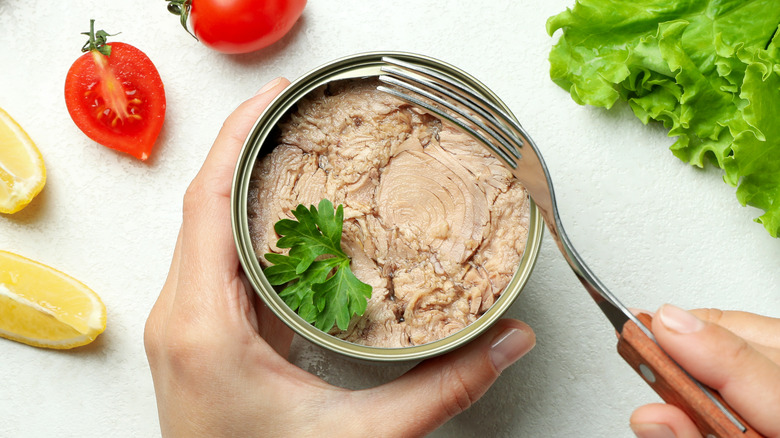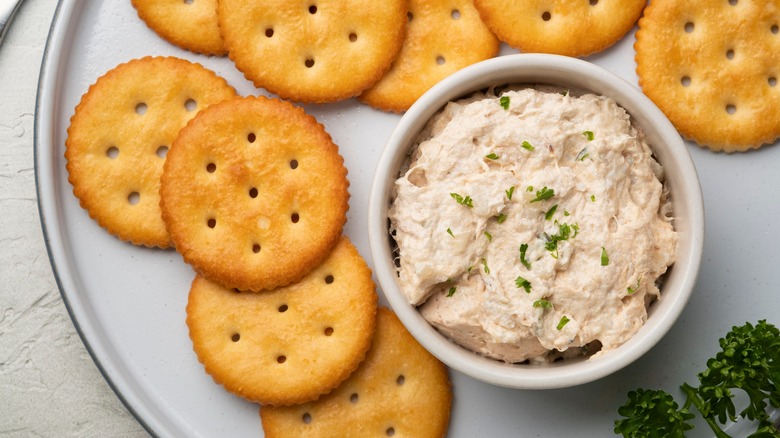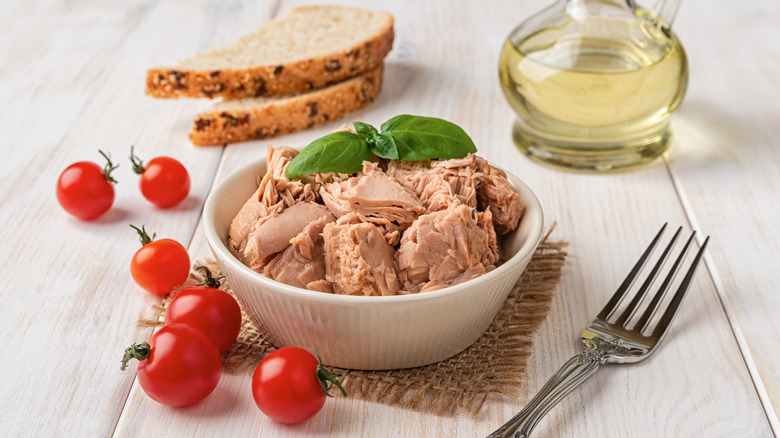How Long Canned Tuna Is Good For Once It's Opened
Canned tuna remains one of the most convenient pantry items in the kitchen. The sturdy tinned fish can last up to five years without spoiling or losing its quality, giving any home cook more than enough time to come up with ways to use it all up. However, the opposite rings true for opened cans of tuna, as they will be susceptible to spoilage if left out on the counter. Thankfully, you can store any leftovers in the fridge to make them last a little longer, but it's not as simple as popping an open tin onto your refrigerator's shelves.
According to the U.S. Department of Agriculture, low-acid canned goods like tuna can last up to four days in the fridge. Waiting any longer to finish your fish puts you at risk of ingesting foodborne pathogens, so you'll want to consume any leftovers lickety-split. To ensure your food does not dry out or lose its flavor prematurely, place it in an airtight container. This will keep your tuna from becoming cross-contaminated by external odors, other foods, or spills, preventing it from spoiling prematurely.
Sadly, canned tuna does not freeze well
While many foods tend to last indefinitely in the freezer without much trouble, canned tuna is not one of those items. Foods with a high water content do not hold up well below freezing, as it causes their internal moisture to crystallize and expand. This tends to ruin the delicate textures of most canned goods, leaving you with a mushy product once it thaws.
Oil-packed rather than water-packed tuna will likely have fewer issues with freezing due to the fact that fats, unlike water, do not expand when frozen. However, these are typically more expensive, and you'd still have to deal with the high moisture content inside the fish. Therefore, you're better off staying away from the freezer altogether unless you're dealing with a fresh filet.
Thankfully, getting through a tin of tuna within four days shouldn't be much trouble. Most canned fish come in small containers since most customers only use them for quick meals, snacks, or dips. Those options alone should give you enough ways to enjoy any leftover tuna meat, but if you're still struggling to finish it up, feel free to incorporate it into heartier dishes such as casseroles, pasta, and even burger patties.
When to ditch the canned tuna
Before you even think about putting that leftover canned tuna in the fridge, make note of how long it has sat out at room temperature. The U.S. Department of Agriculture recommends that all leftovers be discarded if they've sat out on the counter for two hours or longer, as they have likely become compromised by foodborne pathogens. This time frame gets cut down to 60 minutes if you're dealing with temperatures above 90 degrees Fahrenheit, so try to make a habit of storing leftovers promptly instead of after a meal.
The conditions of your fish's original tin and where it sat out prior to opening should also tell you if it's worth storing as leftovers or not. Typically speaking, cans with deep surface dents or that have sat in warm, humid places (the worst place to store your canned tuna) such as the counter near your stove should not be consumed, as they are likely damaged and might be infected with foodborne pathogens.
Once you've checked off your canned tuna and put it in the fridge, you'll have to watch for any signs of premature spoilage. Any dark discoloration marks, rancid smells, or visible mold should be strong indicators that your fish has gone off and should not be consumed. Not all signs of spoilage are visible to the naked eye, so try to use up any leftovers within four days to minimize your chances of getting food poisoning.



